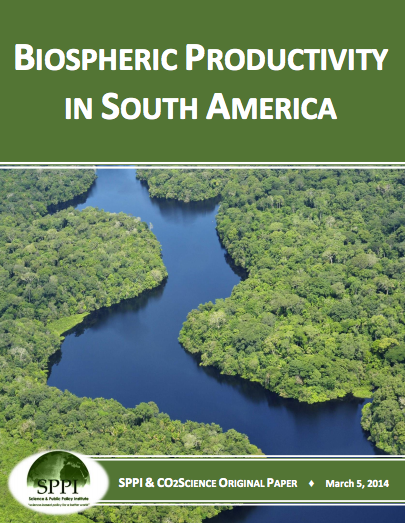News / Random
Biospheric Productivity in South America

How will the terrestrial vegetation of South America respond to global warming and atmospheric CO2 enrichment? Climate alarmists suggest there will be widespread declines in both ecosystem size and productivity. But are these predictions correct? Given the fact that over the past century the Earth has experienced what alarmists refer to as unprecedented rises in both atmospheric temperature and CO2 concentration relative to the past two thousand years and several million years, respectively, plants should already be responding to the changes in these two environmental parameters. And what has that response been? In this summary we consider this question as it applies to locations in South America.
We begin with the long view of the situation provided by Beerling and Mayle (2006) , who investigated the nature of Amazonian ecosystem response to the large-scale environmental changes experienced during glacial-interglacial cycles via a series of 21,000-year simulations. This they accomplished using a dynamic process-based ecosystem model for three scenarios: (1) real-world glacial-to-interglacial changes in CO2 concentration and climate, (2) the real world change in CO2 with a constant preindustrial climate, and (3) the real-world change in climate with a constant preindustrial CO2 concentration. So what did they learn?
During the last glacial maximum, according to the authors, the model suggested that "total above-ground carbon storage in Amazonia was half preindustrial values, indicative of rain forests with markedly lower canopy densities and simpler structures due to lowered CO2 levels, corroborating modeling studies by Cowling (2004) and Cowling et al. (2001)." Thereafter, they say that "biome shifts in ecotonal areas since the last glacial maximum ["the competitive replacement of drought-adapted vegetation (e.g. savanna or deciduous/semideciduous dry forest) by rain forest"] were driven predominantly by climate change, while coincident, increased ecosystem carbon storage throughout the Amazon Basin was driven largely by CO2."
What do these findings have to do with us today? In answering this question, Beerling and Mayle say "the underlying cause for the observed trend of increasing biomass in long-term Amazonian forest plots over recent years, despite drought-induced El Niño events (Phillips et al., 1998; Baker et al., 2004a), has been a subject of considerable debate (Baker et al., 2004a; Wright, 2005)," and in this regard they conclude that "this biomass increase is part of a longterm historical trend driven by anthropogenically induced rising CO2 levels since the 19th century."
